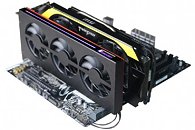Thursday, September 21st 2017
Jonsbo Announces the VF-1 Graphics Card Cooler
Jonsbo has introduced a somewhat strange product to its lineup - a companion cooler to your graphics card. This cooler isn't meant to be installed directly on your graphics card, as some other aftermarket coolers like the Arctic Cooling Accelero series are; instead, this one is meant to be installed in an expansion slot (and a PCIe x16 at that, of all things) below your graphics card, providing additional cooling to your card's reference or custom cooler.
The VF-1 has an anodized aluminum magnesium alloy enclosure, which features a LED lighting accent towards your side window, and features 3x 80 mm cooling fans that blow air towards your graphics card.The VF-1 apparently operates at 18 dBA with the fans at their maximum 1500 RPM, and uses a SATA power connector instead of a fan header. The VF-1 measures 134 x 270 mm and is 20 mm thick, while the aluminum shroud material itself is 1.2 mm thick. It weighs 372 grams, and for all this, Jonsbo is quoting a 5ºC improvement in your graphics card's operating temperatures, which is... pretty underwhelming.
Source:
ETeknix
The VF-1 has an anodized aluminum magnesium alloy enclosure, which features a LED lighting accent towards your side window, and features 3x 80 mm cooling fans that blow air towards your graphics card.The VF-1 apparently operates at 18 dBA with the fans at their maximum 1500 RPM, and uses a SATA power connector instead of a fan header. The VF-1 measures 134 x 270 mm and is 20 mm thick, while the aluminum shroud material itself is 1.2 mm thick. It weighs 372 grams, and for all this, Jonsbo is quoting a 5ºC improvement in your graphics card's operating temperatures, which is... pretty underwhelming.


34 Comments on Jonsbo Announces the VF-1 Graphics Card Cooler
The only benefit i can see with this, is that as you can keep the card a few degress cooler and by that boost will not throttle clocks so much down. FE/blower style cards cut properly benefit from it since blower style cards tends to run hotter than cards with aftermarked cooler.
Else its nothing else than a another useless hardware in my eyes.
doesnt this interfere with airflow? it would make more sense of the original card's shroud & fan are removed so it's only empty heatsinks
i have a... either noname or zalamn bracket from the early 00s that can hold a fan, it doesnt go into the pci slots, but some part of the case
It was called a "Fan Card".
Otherwise you may as well just cable tie a fan over the top or similar and not lose any slots.
www.newegg.com/Product/Product.aspx?Item=N82E16835200019
Using this under an air cooled custom cardlike in the picture is worthless. I had alpenfohn fan bracket installed just under 980Ti 6G TwinFrozr5. Using 2x80mm fans changed nothing, two 120mm ones (prolimatech blue vortex) moved the temps down by one or two degrees at best. I still have the fan bracket in case I ever use a pci-e ssd, that would do the job nicely I think.
I wonder how it would do plugged in one slot above the gpu, it'd prolly help dump the hot air out of the case pretty darn great.
Cooled my fully sick 9800 Pro :)
This can be super useful if you previously bought a passive cooled graphic card. For that, I can see the application. Stacking it over existing fans just creates vortexes and turbolences that just make things worse, not better. The other application is to lift cold air in really tall cases like I've mentioned before and maybe to cool those super fast PCIe SSD's that have passive heatsink only and placing this next to it should dramatically increase cooling efficiency of otherwise passive cooled component. Other than this, I don't see any other real purpose.
EDIT:
Also, placing it above graphic card could help lift heat away from it. But this means you'd need to have graphic card in a slot lower than top one, forcing you to use 8x PCIe since these days you only get 1x 16 slot. I miss the X58 days where I could stick graphic card in either slot and get 16x speed. I could really tweak the airflow there without affecting bandwidth.